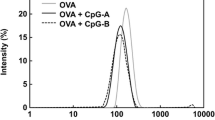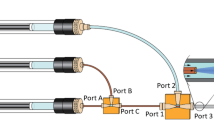Abstract
Purpose. Our purpose was to evaluate the ability of a polymeric vehicle to release a model synthetic vaccine to the skin in order to reach a potent activation of the specific immune response.
Methods. The peptide-loaded poly-d,l-lactide-co-glycolide acid (PLGA) microparticles were prepared by a double emulsion technique and administered to Balb/c mice. The immune response (antibody and T cell activation) obtained by the intradermal (i.d.) and the subcutaneous (s.c.) routes was tested.
Results. When similar doses of peptide-loaded microparticles were injected s.c. or i.d. in mice, the antipeptide IgG antibody immune response was found to be significantly higher after i.d. injection into the skin. We could also reduce the dose of antigen 10 times by the i.d. route and find a similar antibody response to that obtained by the s.c. immunization. At the lowest i.d. dose level, the IgG2a/IgG1 ratio was also incremented and the IgE production decreased. The i.d. microparticles induced, at both dose levels, a marked IFN-γ secretion by peptide-stimulated splenocytes and lymph node cells and a significant T cell proliferation in spleen cell cultures.
Conclusions. The results demonstrate that peptide-loaded microparticles were efficiently administered by the i.d. route because lower doses were required and powerful antibody and T cell responses were obtained compared to the conventional s.c. administration.
Similar content being viewed by others
REFERENCES
E. H. Beachey, J. M. Seyer, J. B. Dale, W. A. Simpson, and A. W. Kang. Type-specific protective immunity evoked by synthetic peptide of Streptococcus pyogenes M protein. Nature 292:457-459 (1981).
J. L. Bittle, R. A. Houghten, H. Alexander, T. M. Shinnick, J. G. Sutcliffe, R. A. Lerner, D. J. Rowlands, and F. Brown. Protection against foot-and-mouth disease by immunization with a chemically synthesized peptide predicted from the viral nucleotide sequence. Nature 298:30-33 (1982).
W. Zauner, K. Lingnau, F. Mattner, A. von Gabain, and M. Buschle. Defined synthetic vaccines. Biol. Chem. 382:581-595 (2001).
Y. Men, B. Gander, H. P. Merkle, and G. Corradin. Induction of sustained and elevated immune responses to weakly immunogenic synthetic malarial peptides by encapsulation in biodegradable polymer microspheres. Vaccine 14:1442-1450 (1996).
J. S. Moyniham, D. H. Jones, G. H. Farrar, and C. R. Howard. A novel microencapsulated peptide vaccine against hepatitis B. Vaccine 19:3292-3300 (2001).
D. F. Nixon, D. F. C. Hioe, P. Chen, Z. Bian, P. Kuebler, M. L. Li, H. Qiu, X. M. Li, M. Singh, J. Richardson, P. McGee, T. Zamb, W. Koff, C. Y. Wang, and D. O'Hagan. Synthetic peptides entrapped in microparticles can elicit cytotoxic T cell activity. Vaccine 14:1523-1530 (1996).
J. E. Rosas, J. L. Pedraz, R. M. Hernández, A. R. Gascón, M. Igartua, F. Guzmán, R. Rodríguez, J. Cortés, and M. E. Patarroyo. Remarkably high antibody levels and protection against P. falciparum malaria in Aotus monkeys after one single immunization of SPf66 encapsulated in PLGA microspheres. Vaccine 20:1707-1710 (2002).
C. Scheicher, M. Mehlig, H. P. Dienes, and K. Reske. Uptake of microparticle-adsorbed protein antigen by bone marrow-derived dendritic cells results in up-regulation of interleukin-1α and interleukin-12 p40/p35 and triggers prolonged, efficient antigen presentation. Eur. J. Immunol. 25:1566-1572 (1995).
J. Banchereau and R. M. Steinman. Dendritic cells and the control of immunity. Nature 392:245-252 (1998).
F. Rahman, A. Dahmen, S. Herzog-Hauff, W. O. Böcher, P. R. Galle, and H. F. Löhr. Cellular and humoral immune responses induced by intradermal or intramuscular vaccination with the major hepatitis B surface antigen. Hepatology 31:521-527 (2000).
E. A. Henderson, T. J. Louie, K. Ramotar, D. Ledgerwood, K. M. Hope, and A. Kennedy. Comparison of higher-dose intradermal hepatitis B vaccination to standard intramuscular vaccination of healthcare workers. Infect. Control Hosp. Epidemiol. 21:264-269 (2000).
E. Jäeger, H. Bernhard, P. Romero, M. Ringhoffer, M. Arand, J. Karbach, C. Ilsemann, M. Hagedorn, and A. Knuth. Generation of cytotoxic T-cell reponses with synthetic melanoma-associated peptides in vivo: implications for tumor vaccines with melanoma-associated antigens. Int. J. Cancer 66:162-169 (1996).
B. Asjo, H. Stavang, B. Sorensen, I. Baksaas, J. Nyhus, and N. Langeland. Phase I trial of a therapeutic HIV type 1 vaccine, vacc-4x, in HIV type 1-infected individuals with or without antiretroviral therapy. AIDS Res. Hum. Retrov. 18:1357-1365 (2002).
B. Ludewig, F. Barchiesi, M. Pericin, R. M. Zinkernagel, H. Hengartner, and R. A. Schwendener. In vivo antigen loading and activation of dendritic cells via a liposomal peptide vaccine mediates protective antiviral and antitumor immunity. Vaccine 19:23-32 (2001).
M. E. Patarroyo, R. Amador, P. Clavijo, A. Moreno, F. Guzmán, P. Romero, R. Tascón, A. Franco, L. A. Murillo, G. Pontón, and G. Trujillo. A synthetic vaccine protects humans against challenge with asexual blood stages of Plasmodium falciparum malaria. Nature 332:158-161 (1988).
R. A. Houghten. General method for the rapid solid-phase synthesis of large numbers of peptides: specificity of antigen-antibody interaction of the level of individual amino acids. Proc. Natl. Acad. Sci. U. S. A. 82:5131-5135 (1985).
Anonymous. Removal of blood from laboratory mammals and birds. First report on the BVA/FRAME/RSPCA/UFAW Joint Working Group on refinement. Lab. Anim. 27:1-22 (1993).
T. Mosmann. Rapid colorimetric assay for cellular growth and survival: application to proliferation and cytotoxicity assays. J. Immunol. Meth. 65:55-63 (1983).
G. Lombardi, C. Dianzani, G. Miglio, P. L. Canonico, and R. Fantozzi. Characterization of ionotropic glutamate receptors in human lymphocytes. Br. J. Pharmacol. 133:936-944 (2001).
A. M. Carcaboso, R. M. Hernández, M. Igartua, J. E. Rosas, M. E. Patarroyo, and J. L. Pedraz. Immune response after oral administration of the encapsulated malaria synthetic peptide SPf66. Int. J. Pharm. 260:273-282 (2003).
S. Babiuk, M. Baca-Estrada, L. A. Babiuk, C. Ewen, and M. Foldvari. Cutaneous vaccination: the skin as an immunologically active tissue and the challenge of antigen delivery. J. Control. Rel. 66:199-214 (2000).
N. Puri, E. H. Weyand, S. M. Abdel-Rahman, and P. J. Sinko. An investigation of the intradermal route as an effective means of immunization for microparticulate vaccine delivery systems. Vaccine 18:2600-2612 (2000).
K. D. Newman, P. Elamanchili, G. S. Kwon, and J. Samuel. Uptake of poly(D,L-lactic-co-glycolic acid) microspheres by antigen-presenting cells in vivo. J. Biomed. Mater. Res. 60:480-486 (2002).
S. L. Constant and K. Bottomly. Induction of Th1 and Th2 CD4+ T cell responses: the alternative approaches. Annu. Rev. Immunol. 15:297-322 (1997).
L. F. Wang, J. Y. Lin, K. H. Hsieh, and R. H. Lin. Epicutaneous exposure of protein antigen induces a predominant Th2-like response with high IgE production in mice. J. Immunol. 156:4079-4082 (1996).
S. Vrtala, T. Ball, S. Spitzauer, B. Pandjaitan, C. Suphioglu, B. Knox, W. R. Sperr, P. Valent, D. Kraft, and R. Valenta. Immunization with purified natural and recombinant allergens induces mouse IgG1 antibodies that recognize similar epitopes as human IgE and inhibit the human IgE-allergen interaction and allergen-induced basophil degranulation. J. Immunol. 160:6137-6144 (1998).
D. Chen, R. L. Endres, C. A. Erickson, K. F. Weis, M. W. McGregor, Y. Kawaoka, and L. G. Payne. Epidermal immunization by a needle-free powder delivery technology: immunogenicity of influenza vaccine and protection in mice. Nat. Med. 6:1187-1190 (2000).
J. A. Mikszta, J. B. Alarcon, J. M. Brittingham, D. E. Sutter, R. J. Pettis, and N. G. Harvey. Improved genetic immunization via micromechanical disruption of skin-barrier function and targeted epidermal delivery. Nat. Med. 8:415-419 (2002).
G. M. Glenn, D. N. Taylor, X. Li, S. Frankel, A. Montemarano, and C. R. Alving. Transcutaneous immunization: a human vaccine delivery strategy using a patch. Nat. Med. 6:1403-1406 (2000).
Author information
Authors and Affiliations
Corresponding author
Rights and permissions
About this article
Cite this article
Carcaboso, Á.M., Hernández, R.M., Igartua, M. et al. Enhancing Immunogenicity and Reducing Dose of Microparticulated Synthetic Vaccines: Single Intradermal Administration. Pharm Res 21, 121–126 (2004). https://doi.org/10.1023/B:PHAM.0000012159.20895.5b
Issue Date:
DOI: https://doi.org/10.1023/B:PHAM.0000012159.20895.5b




